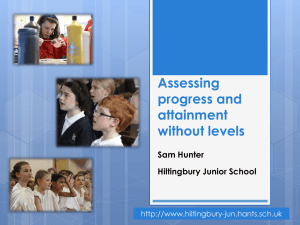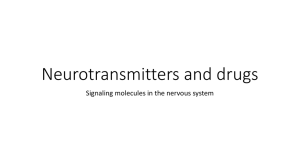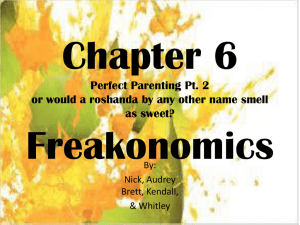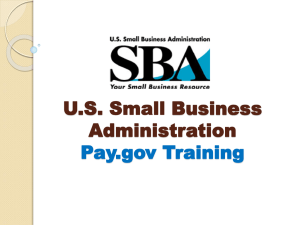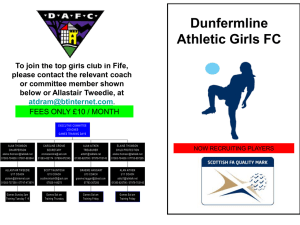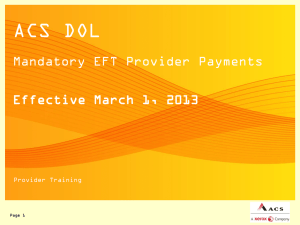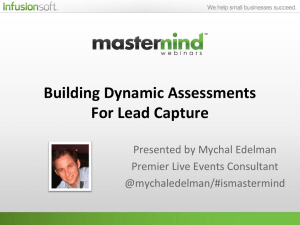WJ III Achievement PP
advertisement
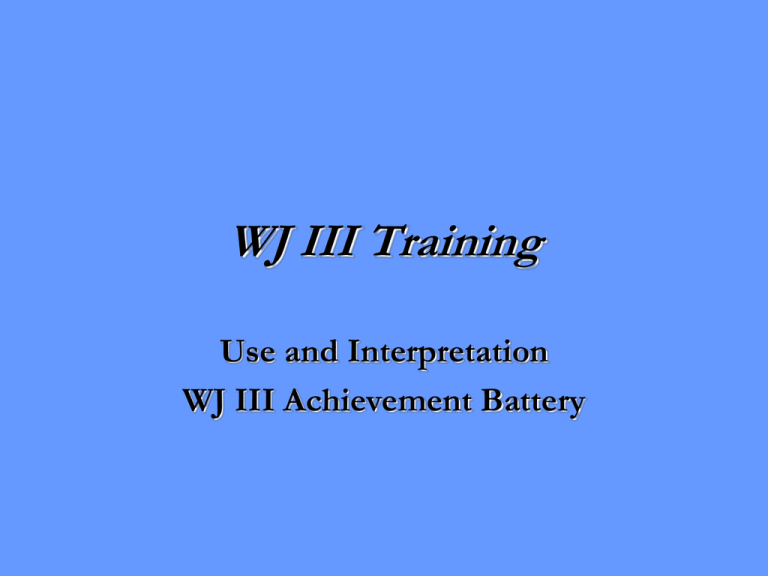
WJ III Training Use and Interpretation WJ III Achievement Battery WJ III TESTS OF ACHIEVEMENT READING TESTS & CLUSTERS ACH 1 Letter-Word Identification • Requires identifying and reading isolated letters and words - sight recognition and identification task • Basal/Ceiling Rules: 6 lowest correct/6 highest incorrect • Know exact pronunciation of words • Responses must be pronounced as a complete word to receive credit Clusters Broad Ability Broad Reading Basic Reading Skills Academic Skills Total Achievement Reading-Writing (Grw) Narrow Ability Reading Decoding ACH 13 Word Attack • Requires decoding of pseudowords • Use Suggested Starting Points • Basal/Ceiling Rules: 6 lowest correct/6 highest incorrect • Know pronunciation prior to administering test • Responses must be pronounced as a complete word to receive credit Broad Ability Clusters Reading-Writing (Grw) Basic Reading Skills Phoneme/Grapheme Knowledge Narrow Abilities Reading Decoding Phonetic Coding: Analysis & synthesis ACH 21 Sound Awareness • Requires manipulating phonemes to produce oral responses • 4 subtests: 21A Rhyming, 21B Deletion, 21C Substitution, 21D Reversal • Administer samples to all subjects and then Item 1 on each subtest • Ceiling Rules apply to each subtest: A & B=4 highest incorrect, C & D=3 highest incorrect Cluster Phonemic Awareness 3 (requires 2 Cognitive tests) Broad Ability Auditory Processing (Ga) Narrow Ability Phonetic Coding: Analysis & Synthesis ACH 2 Reading Fluency • Requires reading and comprehending simple sentences rapidly (uses SRB) • Start with Item 1/End with 3-minute time limit • Skipped items are NOT scored as a “0” - they are ignored for the purpose of scoring • If fewer than 3 correct on Practice Exercises C-F, discontinue testing and score test a “0” Clusters Broad Ability Broad Reading Reading-Writing (Grw) Academic Fluency Narrow Ability Total Achievement Reading Speed ACH 9 Passage Comprehension • Requires reading a short passage and supplying a key missing word • Basal/Ceiling Rules: 6 lowest correct/6 highest incorrect • Use Suggested Starting Points • Accept responses that differ in tense or number • Score responses that are different parts of speech as “0” Clusters Broad Ability Broad Reading Reading-Writing (Grw) Reading Comprehension Narrow Abilities Academic Applications Total Achievement Reading Comprehension Lexical Knowledge ACH 17 Reading Vocabulary • Requires reading words and providing synonyms, antonyms, and completing analogies • 3 subtests: 17A Synonyms, 17B Antonyms, 17C Analogies • Administer samples for each subtest to all subjects • Use Suggested Starting Points for each subtest • Basal/Ceiling Rules apply to each subtest: 4 lowest correct/4 highest incorrect Broad Ability Cluster Reading-Writing (Grw) Reading Comprehension Narrow Abilities Language Development / Comprehension WJ III TESTS OF ACHIEVEMENT WRITTEN LANGUAGE TESTS G ACH 8 Writing Fluency • Requires formulating and writing simple sentences rapidly (uses SRB) • Begin with Item 1/End with 7-minute time limit • Discontinue if subject has “0” on Samples B-D or 3 or fewer correct in first 2 minutes • Any stimulus words may be read upon request • 3 stimulus words may not be changed in any way Clusters Broad Written Language Written Expression Academic Fluency Total Achievement Broad Ability Reading-Writing (Grw) Narrow Ability Writing Speed Writing Fluency - Examiner Tips • Score as incorrect any items skipped. • Do not penalize for spelling, punctuation, or capitalization errors. • Do not penalize for poor handwriting unless illegible. • Response must be a reasonable sentence to receive credit. • If the sentence is awkward but the meaning is clear, score as 1. • Accept sentences with the understood subject you. • Accept abbreviations or symbols • If a word critical to the meaning is omitted, score as 0. • Omission of less meaningful word is not penalized. ACH 11 Writing Samples • Requires writing sentences in response to a series of demands that increase in difficulty (uses SRB) • Use Suggested Starting Points • Administer Block of Items • Administer additional block of items if score falls in or near shaded area of scoring table Clusters Broad Written Language Written Expression Academic Applications Total Achievement Broad Ability Reading-Writing (Grw) Narrow Ability Writing Ability Writing Samples Scoring Responses Block of Items 2 • 1 to 6 1.5 • 1 to 12 • 7 to 18 • 13 to 24 • 19 to 30 1 .5 0 superior response not clearly a 2, but better than a 1 point standard response not clearly a 1, but better than a 0 inadequate or illegible Examiner Tips • Use Scoring Guide in Appendix B of Examiner Manual. • Items may be scored 2, 1.5, 1, .5, or 0 even if no example is shown in Scoring Guide. • Score is based on one block even if additional blocks were administered. Writing Samples - Examiner Tips • Severe grammatical or usage errors - reduce score by 1 point (omission of critical words, extremely awkward sentences) • Multiple Sentences - Select and score the one sentence that most closely meets tasks demands. • Inappropriate Content - Responses that have little to do with the requested task are scored as 0. • Misinterpretation of Picture - Ignore and score response according to item criteria. • Two Raters - Two independent raters score items and resolve any score differences of more than 1 point. Average the two scores to obtain final number correct. • Round scores - ending in .5 to nearest even number (15.5 = 16, 16.5=16) Writing Evaluation • Handwriting Legibility Scale (Appendix C) • Uses a match to sample approach • Scale of 0-100, 10 point increments • Handwriting Elements Checklist (Test Record) • 6 elements: slant, spacing, size, horizontal alignment, letter formation, line quality • Writing Evaluation Scale (Appendix D) • Facilitates evaluation of longer, more complex passages • Uses an analytic scoring method, providing more specific information about strengths & weaknesses L ACH 7 Spelling • Requires writing letters and words presented orally (uses SRB) • Basal/Ceiling Rules: 6 lowest correct/6 highest incorrect • Use Suggested Starting Points based on present level of spelling skill • Modified from Dictation in WJ-R - no punctuation, capitalization, or usage items Clusters Broad Written Language Basic Writing Skills Academic Skills Total Achievement Broad Ability Reading-Writing (Grw) Narrow Ability Spelling Spelling • Items 1-4 Prewriting with demonstration • Items 5-6 Tracing with demonstration • Item 7 Copying a letter • Items 9-13 Printing letters • Items 14-59 Spelling words Examiner Tips • Do not penalize poor handwriting or reversed letters as long as the letter does not become a new letter. (b = d) • Accept uppercase or lowercase responses unless case is specified. • Know the exact pronunciation of the word for each item. • Request responses be printed but accept cursive. ACH 20 Spelling of Sounds • Requires spelling pseudowords that conform to English spelling rules - regular and irregular patterns (use SRB) • Use Suggested Starting Points • Administer Samples A-D and Items 1-5 orally • Basal/Ceiling Rules: 4 lowest correct/4 highest incorrect • Answers listed are the only acceptable responses Broad Ability Cluster Phoneme/Grapheme Knowledge Auditory Processing (Ga) Narrow Abilities Spelling Phonetic Coding: Analysis Spelling of Sounds - Samples A. I am going to ask you to write some letters. I will tell you the sound that the letter makes and then you write the letter. For example, I may say: Write the letter than makes the /s/ sound as in sand. Since the letter “s” makes the /s/ sound, you would write an “s.” Now you write the letter “s” here. C. I am going to ask you to spell some words that are not real words--they are nonsense words. Nonsense words may sound like “bip,” “ost,” or “mib.” Try to spell this nonsense word the way you think it would be spelled if it were a real word. Listen carefully. I will say the nonsense word twice and then you write it. “Ut, ut.” Error or No Response • Follow the error correction procedure in Test Book for all sample items. Spelling of Sounds - Scoring • Items 1-5: score 1 if correct letter is written • Items 13-28: score 1 if spelling matches responses listed in Test Book • Items 6-12: multi-point items (1 for each correctly written and sequenced sound or word part) Item Points 6. Gat (3) (g-a-t) 12. Jong (3) (j-o-ng) Response “gate” “gt” “gonk” “ong” Score 2 2 1 2 Examiner Tips • Spelling must be a common English spelling pattern to receive credit e.g., litch vs. lich. • Deduct points for sounds omitted, sounds that have been altered by extra letters, or sounds out of sequence. G ACH 16 Editing • Requires orally identifying and correcting errors in written passages • Administer Samples A-D to all subjects • Use Suggested Starting Points • Basal/Ceiling Rules: 6 lowest correct/6 highest incorrect • Discontinue testing if subject has 0 on Samples A-D, or on Items 1-4 Broad Ability Cluster Reading-Writing (Grw) Basic Writing Skills Narrow Abilities Language Development English Usage ACH 5 Calculation • Requires calculation of problems ranging from simple addition facts to calculus (uses SRB) • Basal/Ceiling Rules: 6 lowest correct/6 highest incorrect • Skipped items are scored as a “0” • Do not point out signs • Accept reversals but not transposed numbers Clusters Broad Mathematics Math Calculation Skills Academic Skills Total Achievement Broad Ability Mathematics (Gq) Narrow Ability Mathematics Achievement ACH 6 Math Fluency • Requires rapid calculation of single-digit addition, subtraction, and multiplication facts (uses SRB) • Begin with Item 1/End with 3-minute time limit • Skipped items are scored as a “0” • Point out signs only once in directions as indicated • Discontinue if 3 or less correct after 1 minute Clusters Broad Mathematics Math Calculation Skills Academic Fluency Total Achievement Broad Ability Mathematics (Gq) Narrow Abilities Mathematics Achievement Numerical Facility ACH 10 Applied Problems • Requires comprehending the nature of a problem, identifying relevant information, performing calculations, and stating solution • Basal/Ceiling Rules: 6 lowest correct/6 highest incorrect • No reading is required Clusters Broad Mathematics Broad Ability Mathematics (Gq) Math Reasoning Narrow Abilities Academic Applications Quantitative Reasoning Total Achievement Math Achievement Knowledge of Mathematics ACH 18 Quantitative Concepts • Requires applying mathematical concepts and analyzing numerical relationships (use SRB) • 2 subtests: 18A Concepts, 18B Number Series • Use Suggested Starting Points for each subtest • Basal/Ceiling Rules: 18A 4 / 4 18B 3 / 3 • Each item in 18B has a 1-minute time limit Broad Ability Cluster Mathematics (Gq) Math Reasoning Narrow Abilities Knowledge of Mathematics Quantitative Reasoning WJ III TESTS OF ACHIEVEMENT ORAL LANGUAGE & ACADEMIC KNOWLEDGE TESTS ACH 3 Story Recall • Requires listening to stories and recalling elements • Use Suggested Starting Points • Follow Continuation Instructions • Do not repeat or replay any stories Clusters Oral Language-STD Oral Language-EXT Oral Expression Broad Ability Comprehension-Knowledge (Gc) Narrow Abilities Language Development Listening Ability Story Recall - Examiner Tips • Pause the audio recording after each story so the subject can respond. • In the Test Record, place a check mark over each element recalled. (elements are separated by slash marks /) • Elements that are bold must be recalled exactly. Other elements can be synonyms or paraphrased. • If necessary, stories can be presented orally. • If Test 12 Story Recall-Delayed will be administered, do not tell subject that stories may need to be recalled later. Story Recall - Story 1 Julie / likes to catch butterflies./ Then she lets them go./ Sample Responses 3 Points Possible She catches butterflies. Julie catches butterflies. Julie likes catching butterflies. She lets them go. (1) (2) (3) Continuation Rules • If subject has 3 or fewer points on Stories 1 and 2, testing may be discontinued. • If subject has 4 or more points on Stories 1 and 2, administer Stories 3 and 4 unless already administered. ACH 4 Understanding Directions • Requires listening to instructions and then pointing to objects in pictures • Use Suggested Starting Points • Follow Continuation Instructions • Let subject review picture for 10 seconds prior to administering items Broad Ability Clusters Comprehension-Knowledge (Gc) Oral Language-STD Narrow Ability Oral Language-EXT Listening Ability Listening Comprehension Language Development Understanding Directions - Examiner Tips • Pause or stop audio recording after last item of each picture. • Do not repeat or replay any item. If an obvious noise (e.g., bell ringing) interferes, finish the picture, then re-administer specific item. • All steps must be completed to receive credit. (any order unless otherwise specified) • Record Number of Points for each picture in space provided in Test Record. • When using the software program, an entry must be made for each picture: Number of Points or “X” if not administered. ACH 12 Story Recall - Delayed • Requires recalling elements of stories presented 30 minutes to 8 days earlier • Only administer stories previously given in Test 3 • Do not include prompts read by examiner in raw score • Scoring is the same as Test 3 Story Recall. In Test Record, place check mark over each part of story recalled accurately. Broad Ability Cluster Long-Term Retrieval (Glr) Delayed Recall (requires Cognitive Test) Narrow Ability Meaningful Memory Story Recall-Delayed The other day (yesterday, earlier today), you heard some short stories. I am going to read a few words from a story, and then you tell me what you remember about the rest of the story. Recall. Present only stories you administered to subject in Test 3 Story 1. Julie likes to catch…. 2. Mary has a dog…. 5. Rick got some glow-in-the-dark… 6. The dinosaur at the museum... Examiner Tips • Record date and time of administration on Test Record. G ACH 14 Picture Vocabulary • Requires naming pictures (familiar to less familiar) • Use Suggested Starting Points • Basal/Ceiling Rules: 6 lowest correct/6 highest incorrect • Point to picture or part of picture as directed • Test by complete pages Broad Ability Clusters Comprehension-Knowledge (Gc) Oral Language-Extended Oral Expression Narrow Abilities Language Development Lexical Knowledge ACH 15 Oral Comprehension • Requires listening to a short passage and providing the missing final word • Administer Samples A & B to all subjects • Use Suggested Starting Points • Basal/Ceiling Rules: 6 lowest correct/6 highest incorrect Clusters Oral Language-Extended Listening Comprehension Broad Ability Comprehension-Knowledge (Gc) Narrow Ability Listening Ability ACH 19 Academic Knowledge • Requires providing an oral response to items presented orally (no reading or writing) • 3 subtests: 19A Science, 19B Social Studies, 19C Humanities • Basal/Ceiling Rules apply to each subtest: 3 / 3 • Use Suggested Starting Points for each subtest • All 3 subtests must be administered to obtain score Broad Ability Cluster Comprehension-Knowledge (Gc) Knowledge Narrow Abilities (requires 1 Cognitive test) General Information (Science, Cultural, Geography) Reading Skills Cognitive and Academic Interactions Word Decoding Phonemic Awareness Working Memory Lexical Speed and Access (RAN) Rapid Single Word Reading Vocabulary Knowledge, Working Memory, Language Development, Inductive Reasoning Fluency for Reading Connected Text Comprehension Reading Development & Implications for Assessment Skill Word Decoding Test Decoding of Pseudowords (e.g. WJ III Word Attack, ITPA-3) Rapid Single Word Reading Comprehension TOWRE Tests of text and vocabulary comprehension.
